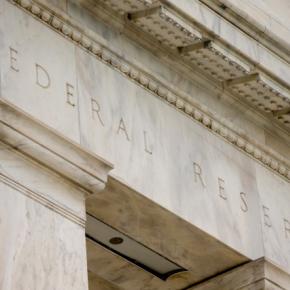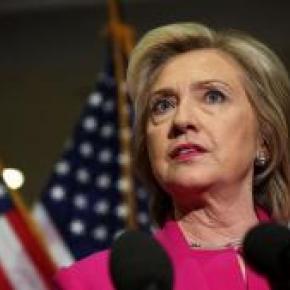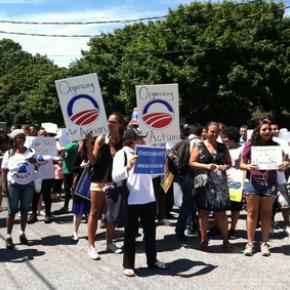'Secure scheduling' rallies focus on giving hourly workers more stability

'Secure scheduling' rallies focus on giving hourly workers more stability
Dive Brief: New York City Mayor DeBlasio and several advocate groups gathered recently to show support for the...
Dive Brief:
New York City Mayor DeBlasio and several advocate groups gathered recently to show support for the introduction of “Fair Workweek” legislation, designed to ensure that 65,000 hourly employees in the fast food industry receive fair notification on work hours.
Currently, employers nationwide aren’t required to provide their hourly employees with advance notice of upcoming shifts. As a result, too many families can't budget in advance, plan for education or family care, or secure a necessary second job, according to advocates.
The New York City event echoes the demands of coalition of New York-based advocates who launched a national campaign on Sept. 6. The groups — the Center for Popular Democracy, the Rockefeller Foundation and the online organization Purpose — are asking for scheduling at least two weeks in advance, eliminating on-call assignments that leave employees "scrambling for child care and unable to hold second jobs with uncertain paychecks."
Dive Insight:
Employers do realize that predictability and fairness are reasonable demands, but more often than not, labor cost (and in some cases, labor shortage) creates problems when trying to create better schedules. Frontline managers are expected to create the schedules while also trying to keep costs down, and balancing the two expectations isn't always successful.
What it will take is better workforce planning, with some technology solutions already available to help make that happen, say experts. Also, there are potential negative legal and compliance outcomes for employers who don't follow state and local laws that already require "reporting pay" time be allowed.
By Tom Starner
Source
Here's How to Make the Fed More Transparent and Accountable
The Federal Reserve has long faced fierce scrutiny from members of Congress, community leaders, and the press for its...
The Federal Reserve has long faced fierce scrutiny from members of Congress, community leaders, and the press for its lack of transparency. Fed Chair Janet Yellen, still early in her term, has signaled an intention to improve transparency and hold the Fed accountable to the public interest, and she’ll face an important test this month as she starts deciding whom to appoint to the newly formed Community Advisory Council.
In the most recent example of Fed’s insular system of governance, Bloomberg Business revealed concerning news about the recent appointment of Patrick Harker as president of the Philadelphia Federal Reserve. Harker had served on the bank’s Board of Directors prior to his appointment, and was even on the search committee interviewing candidates for the presidential slot. Then, in a behind-the-scenes maneuver reminiscent of Dick Cheney’s infamous self-selection as George W. Bush’s running mate, Harker became a candidate for the job himself, and was swiftly chosen by his Board colleagues. Harker’s shadowy appointment process was par for the course at the Fed. In Dallas, the presidential appointment process has been downright dynastic: the outgoing president, Richard Fisher, appointed an advisory committee made up of the people who appointed him to help select his successor.
Chair Yellen has an immediate opportunity to reverse course and change the face of the Fed. This year, the Fed announced the creation of a Community Advisory Council, intended to offer Fed leaders “diverse perspectives” on the economy, “with a particular focus on the concerns of low- and moderate-income populations.” Applications for the Community Advisory Council were due last week. The question facing Fed officials is whether they will appoint individuals to the Council who represent low- and moderate-income voices, or whether the Council will be another elite echo chamber (one earlier predecessor to the Council was heavy on members from for-profit lenders like Capital One and Citigroup—hardly organizations representing the interests of working families).
The announcement of the CAC was a direct response to growing demand for greater public representation at the Fed, and it’s not hard to see why. Of the 108 members of the 12 banks’ boards of directors (which select and oversee those 12 presidents), only 15 come from the nonprofit sector, academia, or labor organizations. The other 93 come from corporations or banks, even though the law requires that two-thirds represent a “diverse” set of interests, including those of labor and consumers. Fed officials lack diversity in other ways, too: among governors and presidents, all but one are white, and the vast majority are men.
Fed officials have huge power over the American economy: They vote on crucial monetary policy decisions, determining whether we reach full employment with rising wages for all or whether the economy continues toward stagnation and inequality. As long as Fed bodies are dominated by the financial sector, their decisions will reflect the perspectives of the very entities the Fed is meant to oversee, rather than the working families across the country who need higher wages and more equitable economic growth.
So, who will lead the Fed in the years to come? Next February, the terms of all 12 regional Fed presidents expire. Their respective Boards of Directors will decide whether to reappoint the presidents or replace them. A coalition of community-based organizations, faith leaders, policy advocates, and labor unions are calling for the Federal Reserve to make this process more transparent. At a bare minimum, the banks should publicize the schedule for the decision-making, the names and roles of the decision-makers, the criteria that will govern the process, and the names of candidates under consideration. A more public process would involve the opportunity for members of the public to serve on the search committees, mechanisms for the public to submit questions and receive answers from prospective candidates, and public forums where Fed officials actually engage in dialogue with the people whom they are supposed to represent. Chair Yellen and officials at the Fed have the power to implement such reforms, and their decisions will speak volumes about their commitment to building an independent central bank with democratic legitimacy.
Janet Yellen’s appointment as the first woman to lead the Fed signaled that change might be coming to a historically opaque institution. But to truly transform the Fed, Yellen and her fellow governors must ensure that the voices of working families aren’t drowned out by wealthy financial interests. The first step is ensuring that the new CAC lives up to its mission by including women, people of color, and representatives of organizations with low- and moderate-income members. It could even directly install some low- and moderate-income individuals on the Council. That would indeed bring new perspective to an institution that has, for too long, been dominated by the voices of America’s elite.
Source: The American Prospect
Liberal groups push Clinton on Wall Street 'golden parachutes'
In a letter sent to Clinton, who is running for the Democratic presidential nomination, the groups pressed her to...
In a letter sent to Clinton, who is running for the Democratic presidential nomination, the groups pressed her to oppose “golden parachutes” given to bank executives when they agree to take high-ranking government jobs. Such a payment structure is not uncommon on Wall Street, but critics of the practice say it encourages a “revolving door” in Washington and undue governmental influence by the financial sector.
The groups asked Clinton if she supported the practice, while noting that two of her main primary opponents — Sen. Bernie Sanders (I-Vt.) and former Maryland Gov. Martin O’Malley — have backed barring the practice.
"The revolving door between government and Wall Street helps the wealthiest few hijack our democracy for their own gain,” said Murshed Zaheed, deputy political director at Credo Action. “Americans cannot afford to have another administration from either party filled with Wall Street executives with multi-million dollar golden parachutes.”
Other groups signing on to the letter were Rootstrikers, Democracy for America, MoveOn.org Political Action, Center for Popular Democracy Action, The Other 98%, Friends of the Earth Action and American Family Voices.
The letter marks the latest in a series of pushes from the left to encourage Clinton to take a harsher stance on the financial sector. Whlie Sanders and O’Malley have hammered the financial sector as a key part of their campaign message, Clinton has taken a more measured tone.
Gripes about a heavy hand from finance in powerful government positions has become a particularly sore spot on the left of late. Sen. Elizabeth Warren (D-Mass.) helped derail President Obama’s nomination of Antonio Weiss, a top executive at Lazard, for a top Treasury post. Warren argued Lazard’s long history on Wall Street should disqualify him for the position, urging someone else to fill the role without such ties. Weiss eventually took a separate post at the Treasury in an advisory role, where he did not need to be Senate-confirmed.
The Clinton campaign did not immediately respond to a request for comment.
Source: The Hill
Rally calling for immigration reform include scores of undocumented immigrants
Penn Live – August 5, 2013, by Ivy DeJesus - Close to 100 protesters rallied on Monday within ear shot of a political...
Penn Live – August 5, 2013, by Ivy DeJesus - Close to 100 protesters rallied on Monday within ear shot of a political event in Harrisburg headlined by House Speaker John Boehner and Rep. Scott Perry (PA-4) to demand immigration reform.
Chanting in English and Spanish, protesters made their way from the City Island parking lot up to the path leading to Metro Bank Park where the Republican lawmakers held a fundraiser.
Protesters carried placards and shouted in unison a string of chants, including: “Serve the needy, not the greedy,” and “Move Boehner, get out of the way. You’re not welcome in Pa.”
The rally was organized by a coalition of advocacy groups, among them Keystone Progress, Pennsylvanians United for Immigration Reform, Center for Popular Democracy and Central PA Area Labor Federation. The majority of participants drove in from other parts of the state or were bused in.
As House members return to their districts for August recess, representatives of the coalition said they intended to take their messages to lawmakers’ local offices.
Perry’s 4th congressional district encompasses York County and parts of Dauphin County.
Hiro Nishikawa, one of the protesters, said that the long-simmering debate is finally getting widespread public attention.
Nishikawa said immigration policy continues to be dictated by outdated laws, including the 1996 law that mandates detention and apprehension of undocumented immigrants who have any prior police records. The law has led to approximately 400,000 undocumented immigrants being detained under the Obama Administration.
“People recognize things are messed up,” Nishikawa said. “The huge concern is the fairness of the law. It needs to be changed.”
Amid widespread calls for an immigration policy overhaul, a deeply divided Congress has been unable to advance any comprehensive reform. President Obama has used his executive power to push some laws that provide pathways to citizenship, including an amnesty program for qualified young people. In spite of a bipartisan Senate bill approved in June, Washington insiders are largely in agreement that the House is not likely to agree on a major bill this year.“We are entrenched in the culture that is America..we are part of the people that are here.” – Jorge Salazar
Rally participants represented a diverse group of people, including church and labor groups, immigrants from a number of countries, and even undocumented immigrants.
Carmen Guerrero, a community organizer from outside Philadelphia, said lawmakers have not given the immigration issue the urgency it deserves.
“The law is broken,” Guerrero said in Spanish. She came from Mexico 13 years ago. “This is a country of immigrants. It’s a country where immigration has to keep moving forward with its law. It’s been too long without reform. It has been reformed but only to attack the immigrant community, to suppress the community.”
Guerrero said that U.S. immigration policy is so cumbersome, many immigrants prefer to sidestep the system and enter the country illegally. She said most countries face daunting obstacles for legal entry, including excessively long waiting periods.
“The opportunity to come here legally is too small,” she said. “At the end of the day, we rather break the law. There is no realization to be able to come legally and be part of society, as we should.”
Guerrero, a single mother of three who has worked two full-time jobs back to back as a hotel housekeeper and restaurant dishwasher, says she pays taxes and is in no way taking jobs away from citizens.
“We are the landscapers, the service, the dishwashsers at the restaurants and hotels,” she said. “I don’t think a professional would want those jobs.” -Jorge Salazar
Another undocumented immigrant, Jorge Salazar acknowledged that it would be difficult to process 11 million undocumented immigrants through the immigration system, but that in the end, it would not burden taxpayers.
“It’s not going to be costly,” he said. “We are going to pay for it. Immigration is one of the few government programs funded by the applicants.”
Salazar’s family arrived from Bolivia 23 years ago, but due to a series of legal mistakes, his family found itself staying put once their visa expired.
Salazar said he considers himself a part of the American society; he said he works and goes to school and is an active member of his community. He traveled to Harrisburg from his Philadelphia suburb home.
He said he and his family were concerned that they were risking deportation by being vocally and actively involved in calling for immigration reform.
“The reality is we have to do this,” he said. “People need to know that we are your neighbors, we are next to you in school, we are next to you in church. All my friends are American citizens. We are entrenched in the culture that is America..we are part of the people that are here.”
Source
Rockefeller Institute Hands over Final Scaffold Law Report Draft
Times Union - September 3, 2014, by Casey Seiler - SUNY’s Nelson A. Rockefeller Institute of Government has released a...
Times Union - September 3, 2014, by Casey Seiler - SUNY’s Nelson A. Rockefeller Institute of Government has released a second draft of its controversial report on New York’s Scaffold Law. According to the Institute’s Deputy Director for Operations Robert Bullock, it’s the last draft version of the report that was shared with the report’s funder, the state Lawsuit Reform Alliance.
The business-backed group, which opposes Scaffold Law, paid $82,800 to fund the report — sponsorship that has led critics to attack the study as advocacy in the guise of research. Its authors, however, insist the research was conducted in good faith.
Scaffold Law, which places “absolute liability” on employers for gravity-related workplace injuries, is supported by labor unions but opposed by business groups that claim it needlessly drives up construction costs. Opponents would like to see New York follow other states by adopting a “comparative negligence” standard that would make workers proportionately responsible when their actions contribute to an accident.
The Center for Popular Democracy, a labor-backed group that supports Scaffold Law, requested copies of all communications between the Institute and the Lawsuit Reform Alliance. That FOIL request produced a series of emails between researchers and LRA Executive Director Tom Stebbins, including Stebbins’ suggested edits to a June 25, 2013, draft copy of the report that was not initially released by the Institute.
The Center appealed to SUNY’s FOIL officer, who ultimately decided the June 25 draft — which had been appended to an email to Stebbins — should be released. A comparison of the draft and the final report suggested that some of Stebbins’ suggestions were reflected in the final version. Researchers, however, said any changes were the result of their efforts to sharpen their analysis, and not made due to pressure from the funder.
The newly released draft, dated Aug. 7, 2013, closely resembles the final report — which neither proves nor disproves the Center’s charges that the academics buckled under pressure.
Josie Duffy of the Center for Popular Democracy, however, claims the six-week gap between the first and second drafts suggests that the Institute moved quickly to follow the Alliance’s edits.
“When LRANY wanted changes, the report’s authors dutifully made them right away — inflating the report’s findings and taking out a key section that challenged how onerous the Scaffold Safety Law really is,” Duffy said in a statement, alluding to the second draft’s disposal of a two-page section on the construction of the Champlain Bridge that found little or no impact on the project from Scaffold Law.
“SUNY says it has now disclosed everything it has, but given that LRANY and the authors held weekly conference calls to discuss the report’s progress, we may never know the full extent of their influence over the final version,” Duffy said.
In an email, Bullock said the Institute “has been open and honest about its contacts with funders and its research has been and will continue to be immune from influence. It is unfortunate that a research organization known throughout the nation for the quality and character of its work should have to defend itself from accusations leveled by the Center for Popular Democracy, an organization well known for its partisanship.”
Update: Stebbins sent the following statement:
“Reform opponents are so terrified of the data that they can do nothing but attack the method of three researchers at two top universities. The Scaffold Law costs billions and causes injuries. If the Center for Popular Democracy wants to have a real discussion about how many billions wasted and how many injuries caused by the Scaffold Law, I will have that discussion all day.”
Source
Mpls. Fed chief, activists talk about economic gap
The president of the Federal Reserve Bank of Minneapolis met with activists and northside residents Wednesday over...
The president of the Federal Reserve Bank of Minneapolis met with activists and northside residents Wednesday over racial and economic disparities.
Neel Kashkari talked with leaders from Neighborhoods Organizing for Change for an hour — an unusual meeting of a banking insider and a group known for street demonstrations and putting political pressure on the powers that be.
"A big part of my job is to get out and understand first hand what is happening, what are the challenges," said Kashkari who has served on the central bank system since January.
In that time, the former head of the federal government's bank bailout program in 2008 has drawn attention for his warning that failure of some big banks could lead to another financial crisis.
Kashkari said that the Fed's monetary policy can have an effect on unemployment, interest rates and inflation, but he said Congress' fiscal policy will also be key in addressing racial disparities.
Anthony Newby, executive director of Neighborhoods Organizing for Change, said they talked about the high unemployment rate among African-Americans.
"Now we can spend more time collaborating, doing a deeper dive and figure out what are the structural barriers and then what can the Fed do to bridge that gap," Newby said. "That's a big deal and big starting point."
Newby added he was pleased to have someone in Kashkari's position listening to real people struggling to make ends meet.
Kashkari agreed to meet with them again.
By PETER COX
Source
GOP pours nearly $1M into Arizona special election
Activist Ady Barkan and New York Times columnist Michelle Goldberg discuss what’s been happening on the ground in...
Activist Ady Barkan and New York Times columnist Michelle Goldberg discuss what’s been happening on the ground in Arizona, where the outcome of the special election in the 8th district is perhaps less important than the margin.
Watch the video here.
Maria Gallagher, Ana Maria Archila and the amazing power of everyday people raising their voice

Maria Gallagher, Ana Maria Archila and the amazing power of everyday people raising their voice
Maria Gallagher, a 23-year-old woman from New York, had never told anyone about the time she was sexually assaulted...
Maria Gallagher, a 23-year-old woman from New York, had never told anyone about the time she was sexually assaulted before she blurted it out to a United States senator, Republican Jeff Flake of Arizona, with millions watching on live national television.
Read the full article here.
Passenger with ALS Calls Out Sen. Jeff Flake on Tax Vote, DACA
Arizona Republican Senator Jeff Flake recently has been masquerading as a Republican with a heart, someone willing to...
Arizona Republican Senator Jeff Flake recently has been masquerading as a Republican with a heart, someone willing to stand up to Donald Trump and others in the GOP whose lack of principles is tearing the country apart.
Flake recently wrote a check for a whopping $100 to support Democratic Senate candidate Doug Jones in Alabama. He claims to have secured political promises from the Trump administration over DACA, which protects immigrants who came to the U.S. as children. (The White House denies there are any deals.)
Read the full article here.
When It Comes to Jobs, Fed Up With the Fed
The News & Observer - March 5, 2015, by Kevin Rogers - When the monthly jobs numbers come out Friday, many...
The News & Observer - March 5, 2015, by Kevin Rogers - When the monthly jobs numbers come out Friday, many economists will say that the economy is healthy. Some will even say that wages are rising too fast and that steps need to be taken to slow economic growth. But out in the real world, working families and particularly communities of color are being left drastically behind in the recovery.
The disconnect between the rich and the rest of us is only widening, and that is a real problem when the rich are making the decisions for everyone. For higher wages and more robust employment growth, we don’t need to limit ourselves to the usual discussions and the typical solutions. Rather, we should look in a new direction, to the Federal Reserve, for the necessary policy changes that will usher in real growth on Main Street, not just on Wall Street.
Most people don’t pay much attention to what the Fed does and how it does it, but the reality is that the decisions the Fed makes affect us all, every day.
There are two important ways the Federal Reserve can help:
▪ Ensure a monetary policy that delivers genuine full employment and rising wages for all working families. Raising interest rates in 2015 would be a catastrophic mistake. The American economy needs to see significantly more wage growth, not less.
▪ Provide a more transparent and inclusive approach to policymaking and governance. The Fed needs to listen to the voices of working families, not just banks and mega corporations.
Rampant and uneven unemployment can be measured in numbers, but it means that real-life opportunities fall further out of reach for working parents and that doors close on our children. It means that families are feeling the strain, and disenfranchisement is getting worse.
Permitting the economy to speed up significantly offers only upsides. A new report by the Center for Popular Democracy and the Economic Policy Institute finds that until nominal wages are rising by 3.5 to 4 percent, there is no threat that price inflation will meaningfully exceed the Fed’s low 2 percent inflation target. And such wage growth is necessary for workers to begin to reap the benefits of economic growth and to achieve a genuine recovery from the Great Recession.
Indeed, during the past three decades, it was only in the late 1990s, when the Federal Reserve permitted economic growth to speed up and the labor market to tighten, that workers across the economic spectrum, and in communities of color, saw genuine wage improvements.
As was true then, the Fed is not an innocent bystander in our economy, but an active participant. And yet, despite the clear economic disparities among our communities, voices inside the Fed are now saying that the economy is healthy and that the Fed should tamp down growth so that wages stop rising so quickly.
Although the board members that govern the regional Federal Reserve banks are legally required to represent the broad interests of the public, they mostly represent the financial sector or large corporations – they live very different lives from us, and they don’t take our experiences to the boardroom.
The Fed’s decisions are distant from communities that struggle the most in this economy and simply do not reflect the full diversity of the public it is supposed to represent. This explains why board members have produced an economy that works for them. Millions of working families are left with little hope of a better life.
It is no wonder that supporters of higher wages and fuller employment from across the country are turning up the heat on out-of-touch policies and practices coming from the Fed. Regular families should not be shut out the Fed policymaking process. Instead, they should be at the very core of it.
Source
Read more here: http://www.newsobserver.com/opinion/op-ed/article12716264.html#storylink...











2 months ago
2 months ago